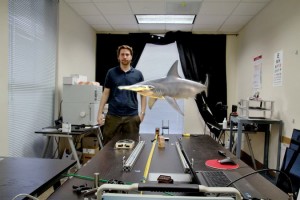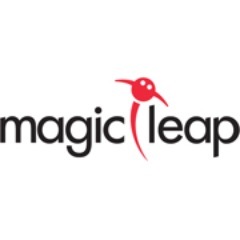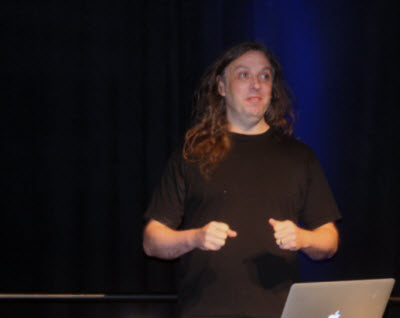Companies
Magic Leap in NY Times: Real-Life Illness in a Virtual World
by John Markoff
New York Times
[Editor’s note: For more about the connection between Magic Leap and Santa Cruz, read How Graeme Devine is going to put Santa Cruz on the map.]
Magic Leap says its digital light field encodes more information about a scene to help the brain make sense of what it is looking at

The start-up Magic Leap, using a different approach called a digital light field, could seamlessly place a swimming shark in an office setting. (Photo credit: Magic Leap)
A 3-D animated creature, affectionately named Gerald, appears to walk in circles while floating in front of an elaborate viewer that resembles something from an optometrist’s office. Though only half a foot high, and with four arms, he looks remarkably lifelike through lenses that transmit what computer scientists and optical engineers describe as a “digital light field” into the eyes of a viewer.
The technology, once downsized into a pair of glasses, is intended to overcome the most significant technical challenges blocking an explosion of virtual reality.
Oculus Rift, the crowdfunded start-up acquired by Facebook for $2 billion in March, has been trying to correct this motion sickness. But it is a steep challenge. Nearly 50 years after the computer scientist Ivan Sutherland pioneered head-mounted computer displays, there are more than two dozen companies that have attempted to commercialize various forms of the technology, called near-eye displays, with little success.
Though the industry could radically transform entertainment, gaming and other forms of computing, it has an Achilles’ heel: Many people become queasy after pulling viewing devices over their eyes and slipping into an immersive world that blurs the line between physical reality and computer-generated imagery.
Continue reading the full article here: http://www.nytimes.com/2014/07/15/science/taking-real-life-sickness-out-of-virtual-reality.html
###
Sara Isenberg publishes Santa Cruz Tech Beat for the benefit of the extended business and technology community. When she is not volunteering her time for the tech scene, Sara makes her living by managing software projects, web strategy planning, and providing development team services (including account management, vendor management, strategic partner management, beta project management, referrals to qualified technical team members, and more). Please visit her website: Sara Isenberg Web Consulting & Project Management, or contact Sara by email if you have any project management, account management, or Development Team leadership or service needs.
Tagged Graeme Devine, Magic Leap, magicleap







